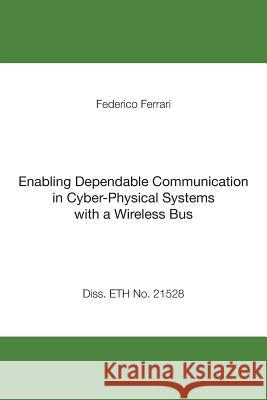Enabling Dependable Communication in Cyber-Physical Systems with a Wireless Bus » książka
Enabling Dependable Communication in Cyber-Physical Systems with a Wireless Bus
ISBN-13: 9781492251033 / Angielski / Miękka / 2015 / 182 str.
Cyber-physical systems (CPSs) are physical and engineered systems believed to radically transform how we interact with the physical world. By tightly integrating computation, low-power wireless communication, and physical processes, these systems realize safety-critical control loops-with physical processes affecting computation and vice versa-in scenarios where traditional systems are hardly applicable. Potential CPS applications include healthcare, factory automation, and smart structures. The safety-critical nature of most CPS applications demands highly dependable system operation. However, it is currently not possible to apply to cyber-physical systems established concepts for the design and validation of dependable distributed systems. These concepts require guarantees (e.g., on message delivery orderings) that existing CPS communication protocols do not provide. It is indeed extremely challenging to guarantee message delivery in low-power wireless networks, due to, for example, severe computation and memory constraints of typical CPS embedded devices, multi-hop wireless communication, and the need of satisfying also requirements on energy efficiency. State-of-the-art solutions try to overcome these challenges by involving in the exchange of messages as few nodes as possible, but they typically operate only in a best-effort manner. By contrast, we conjecture in this thesis that it is possible to enable dependable yet efficient communication in cyber-physical systems by employing a wireless bus-a time-triggered communication infrastructure where, similar to protocols for (wired) safety-critical embedded systems, nodes are time-synchronized and communicate as if they were connected by a shared bus. In particular, we implement three main building blocks contributing towards a dependable wireless bus: We design Glossy, a flooding architecture that provides fast and highly reliable one-to-all communication in multi-hop low-power wireless networks, while also accurately time-synchronizing all devices. Glossy exploits synchronous transmissions of the same packet, and does not require nodes to maintain any knowledge of the network topology. Experimental results from three testbeds show that Glossy delivers messages within a few milliseconds and with probabilities above 99.99 % in most scenarios, while also providing global time synchronization with sub-microsecond accuracy. We present the Low-Power Wireless Bus (LWB), a wireless bus that maps all traffic demands on Glossy floods and globally schedules every flood, thus effectively turning a multi-hop wireless network into an infrastructure similar to a shared bus where all nodes are potential receivers of all data. Therefore, LWB inherently supports one-to-many, many-to-one, and many-to-many traffic without keeping any topology-dependent state at the nodes. Results from four testbeds show that LWB performs comparably or significantly better than seven state-of-the-art many-to-one and many-to-many protocols, adapts efficiently to traffic loads and network topologies varying over time, ensures fair bandwidth allocation, and supports mobile nodes without performance loss. We finally verify the validity of our conjecture by developing VIRTUS, a wireless bus that extends LWB's best-effort operation and provides virtual synchrony guarantees. By implementing atomic multicast and view management, VIRTUS ensures that non-faulty nodes see the same events in the same order despite possible communication failures or node crashes. Virtually-synchronous executions allow to apply to cyber-physical systems established methods for fault tolerance based on replication techniques. Testbed results show that VIRTUS implements virtual synchrony at a marginal cost compared with LWB, and is significantly more energy-efficient than existing best-effort multicast protocols for low-power wireless networks."
Zawartość książki może nie spełniać oczekiwań – reklamacje nie obejmują treści, która mogła nie być redakcyjnie ani merytorycznie opracowana.











